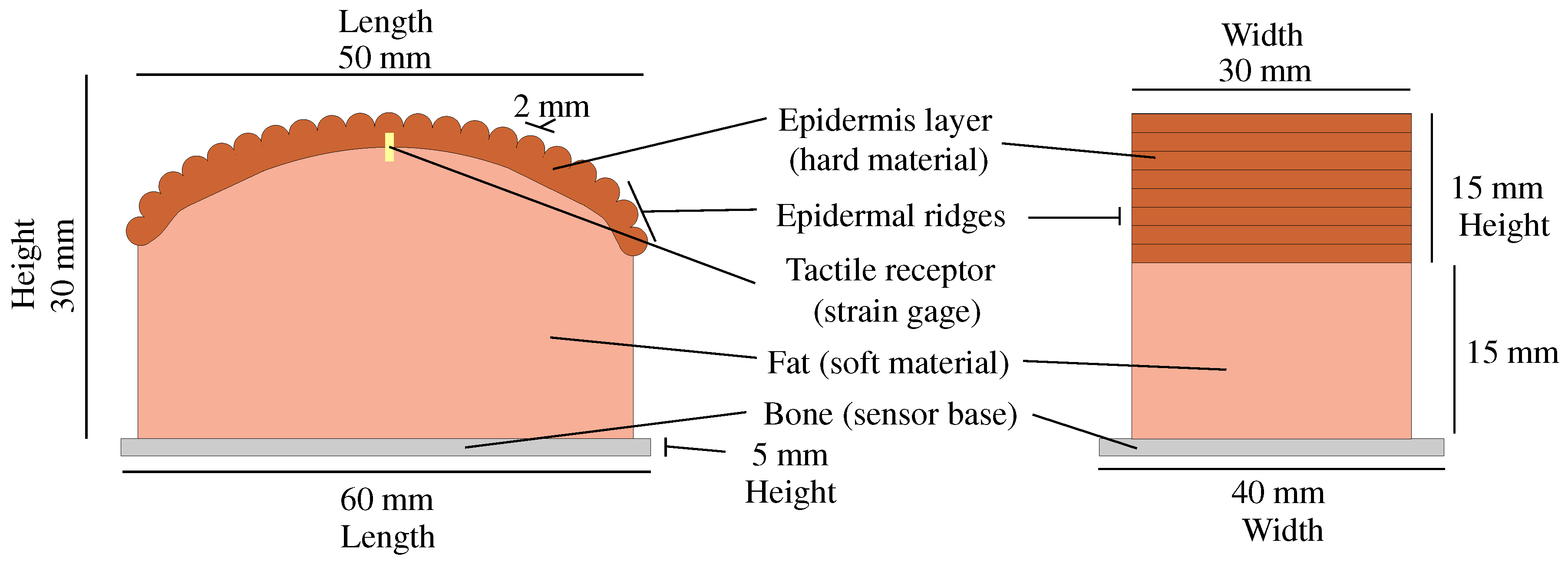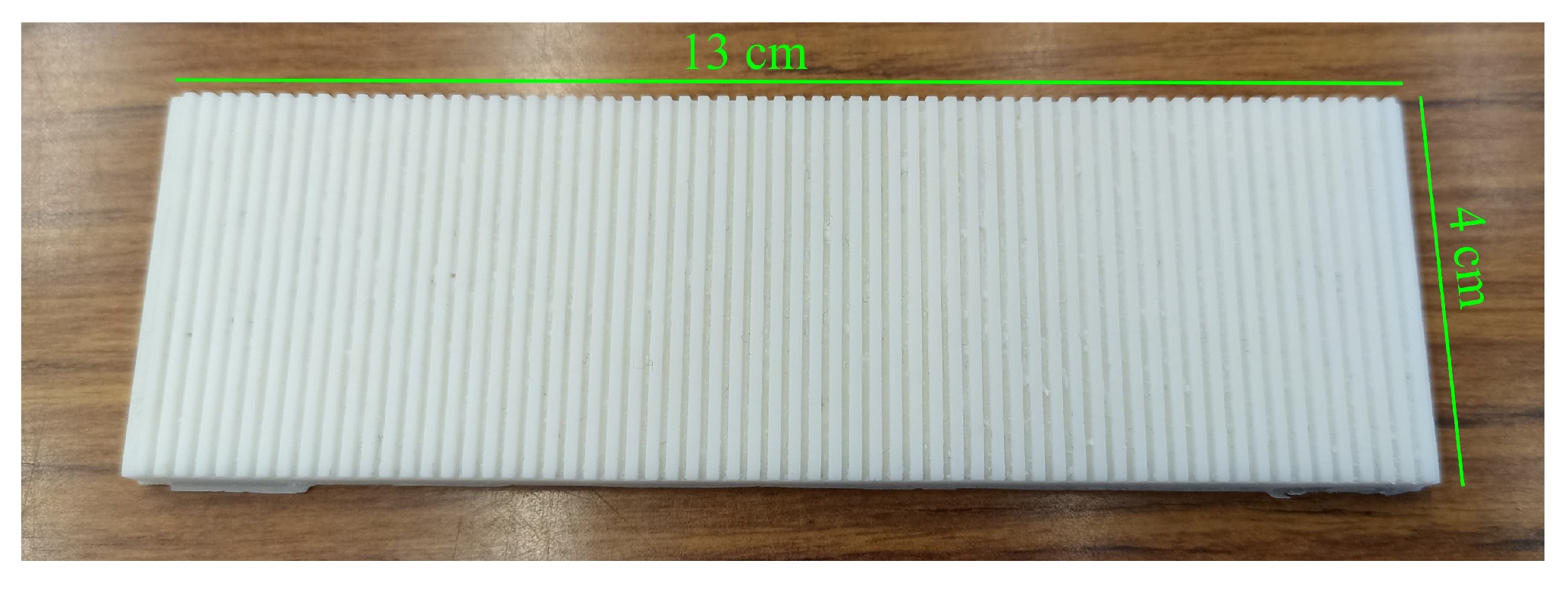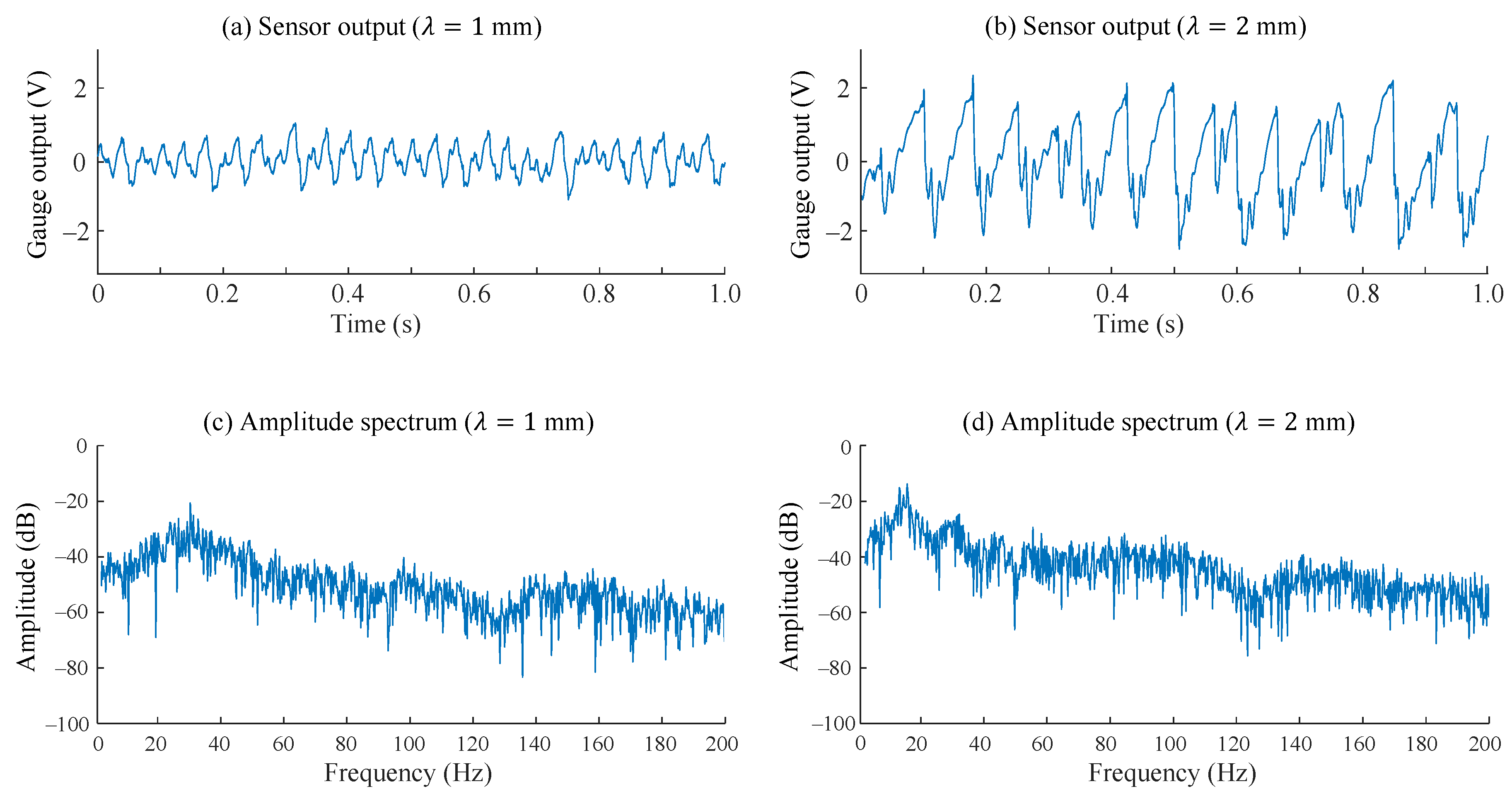Healing Function for Abraded Fingerprint Ridges in Tactile Texture Sensors
Abstract
1. Introduction
2. Sensor Design and Manufacturing
2.1. Structure and Dimensions
2.2. Material
2.3. Transducer
2.4. Sensor Manufacturing
2.5. Healing Processes
3. Experiment
3.1. Textural Specimens
3.2. Scanning Condition
3.3. Data Analysis
4. Results
5. Discussion
6. Conclusions
Author Contributions
Funding
Institutional Review Board Statement
Informed Consent Statement
Data Availability Statement
Conflicts of Interest
References
- Gerling, G.J.; Thomas, G.W. The effect of fingertip microstructures on tactile edge perception. In Proceedings of the 1st Joint Eurohaptics Conference and Symposium on Haptic Interfaces for Virtual Environment and Teleoperator Systems, World Haptics Conference, Pisa, Italy, 18–20 March 2005; pp. 63–72. [Google Scholar] [CrossRef]
- Gerling, G.J. SA-I mechanoreceptor position in fingertip skin may impact sensitivity to edge stimuli. Appl. Bionics Biomech. 2010, 7, 19–29. [Google Scholar] [CrossRef]
- Yum, S.M.; Baek, I.K.; Hong, D.; Kim, J.; Jung, K.; Kim, S.; Eom, K.; Jang, J.; Kim, S.; Sattorov, M.; et al. Fingerprint ridges allow primates to regulate grip. Proc. Natl. Acad. Sci. USA 2020, 117, 31665–31673. [Google Scholar] [CrossRef] [PubMed]
- Fagiani, R.; Massi, F.; Chatelet, E.; Berthier, Y.; Akay, A. Tactile perception by friction induced vibrations. Tribol. Int. 2011, 44, 1100–1110. [Google Scholar] [CrossRef]
- Maeno, T.; Kobayashi, K. FE analysis of the dynamic characteristics of the human finger pad in contact with objects with/without surface roughness. In Proceedings of the Dynamic Systems and Control, American Society of Mechanical Engineers, IMECE98, Anaheim, CA, USA, 15–20 November 1998; pp. 279–286. [Google Scholar] [CrossRef]
- Scheibert, J.; Leurent, S.; Prevost, A.; Debrégeas, G. The role of fingerprints in the coding of tactile information probed with a biomimetic sensor. Science 2009, 323, 1503–1506. [Google Scholar] [CrossRef] [PubMed]
- Ohka, M.; Kawamura, T.; Itahashi, T.; Takayanagi, J.I.; Miyaoka, T.; Mitsuya, Y. A tactile recognition system mimicking human mechanism for recognizing surface roughness. JSME Int. J. 2005, 48, 278–285. [Google Scholar] [CrossRef]
- Ohka, M.; Takayanagi, J.; Kawamura, T.; Mitsuya, Y. A surface-shape recognition system mimicking human mechanism for tactile sensation. Robotica 2006, 24, 595–602. [Google Scholar] [CrossRef]
- Lu, X.; Xie, X.; Gao, Q.; Hu, H.; Yang, J.; Wang, H.; Wang, S.; Chen, R. Design of biomimetic human-skin-like tactile flexible sensor. Sens. Rev. 2019, 39, 397–406. [Google Scholar] [CrossRef]
- Kim, S.J.; Choi, J.Y.; Moon, H.; Choi, H.R.; Koo, J.C. Biomimetic hybrid tactile sensor with ridged structure that mimics human fingerprints to acquire surface texture information. Sens. Mater. 2020, 32, 3787–3799. [Google Scholar] [CrossRef]
- Kim, K.; Sim, M.; Lim, S.H.; Kim, D.; Lee, D.; Shin, K.; Moon, C.; Choi, J.W.; Jang, J.E. Tactile avatar: Tactile sensing system mimicking human tactile cognition. Adv. Sci. 2021, 8, 2002362. [Google Scholar] [CrossRef]
- Wang, H.; Cen, Y.; Zeng, X. Highly sensitive flexible tactile sensor mimicking the microstructure perception behavior of human skin. ACS Appl. Mater. Interfaces 2021, 13, 28538–28545. [Google Scholar] [CrossRef]
- Qu, X.; Xue, J.; Liu, Y.; Rao, W.; Liu, Z.; Li, Z. Fingerprint-shaped triboelectric tactile sensor. Nano Energy 2022, 98, 107324. [Google Scholar] [CrossRef]
- Han, H.Y.; Shimada, A.; Kawamura, S. Analysis of friction on human fingers and design of artificial fingers. In Proceedings of the IEEE International Conference on Robotics and Automation, Minneapolis, MN, USA, 22–28 April 1996; Volume 4, pp. 3061–3066. [Google Scholar]
- Penrose, L.S.; Ohara, P.T. The development of the epidermal ridges. J. Med. Genet. 1973, 10, 201–208. [Google Scholar] [CrossRef] [PubMed]
- Monson, K.L.; Roberts, M.A.; Knorr, K.B.; Ali, S.; Meagher, S.B.; Biggs, K.; Blume, P.; Brandelli, D.; Marzioli, A.; Reneau, R.; et al. The permanence of friction ridge skin and persistence of friction ridge skin and impressions: A comprehensive review and new results. Forensic Sci. Int. 2019, 297, 111–131. [Google Scholar] [CrossRef] [PubMed]
- Tee, B.C.; Wang, C.; Allen, R.; Bao, Z. An electrically and mechanically self-healing composite with pressure- and flexion-sensitive properties for electronic skin applications. Nat. Nanotechnol. 2012, 7, 825–832. [Google Scholar] [CrossRef] [PubMed]
- Yang, M.; Cheng, Y.; Yue, Y.; Chen, Y.; Gao, H.; Li, L.; Cai, B.; Liu, W.; Wang, Z.; Guo, H.; et al. High-performance flexible pressure sensor with a self-healing function for tactile feedback. Adv. Sci. 2022, 9, 2200507. [Google Scholar] [CrossRef] [PubMed]
- Roels, E.; Terryn, S.; Ferrentino, P.; Brancart, J.; Van Assche, G.; Vanderborght, B. An interdisciplinary tutorial: A self-healing soft finger with embedded sensor. Sensors 2023, 23, 811. [Google Scholar] [CrossRef] [PubMed]
- Roels, E.; Terryn, S.; Brancart, J.; Sahraeeazartamar, F.; Clemens, F.; Van Assche, G.; Vanderborght, B. Self-healing sensorized soft robots. Mater. Today Electron. 2022, 1, 100003. [Google Scholar] [CrossRef]
- Jinglei, Y.; Keller, M.W.; Moore, J.S.; White, S.R.; Sottos, N.R. Microencapsulation of isocyanates for self-healing polymers. Macromolecules 2008, 41, 9650–9655. [Google Scholar] [CrossRef]
- Nevejans, S.; Ballard, N.; Miranda, J.I.; Reck, B.; Asua, J.M. The underlying mechanisms for self-healing of poly(disulfide)s. Phys. Chem. Chem. Phys. 2016, 18, 27577–27583. [Google Scholar] [CrossRef]
- Tanasi, P.; Hernández Santana, M.; Carretero-González, J.; Verdejo, R.; López-Manchado, M.A. Thermo-reversible crosslinked natural rubber: A Diels-Alder route for reuse and self-healing properties in elastomers. Polymer 2019, 175, 15–24. [Google Scholar] [CrossRef]
- Li, J.; Ning, Z.; Yang, W.; Yang, B.; Zeng, Y. Hydroxyl-terminated polybutadiene-based polyurethane with self-healing and reprocessing capabilities. ACS Omega 2022, 7, 10156–10166. [Google Scholar] [CrossRef]
- Terryn, S.; Langenbach, J.; Roels, E.; Brancart, J.; Bakkali-Hassani, C.; Poutrel, Q.A.; Georgopoulou, A.; George Thuruthel, T.; Safaei, A.; Ferrentino, P.; et al. A review on self-healing polymers for soft robotics. Mater. Today 2021, 47, 187–205. [Google Scholar] [CrossRef]
- Khatib, M.; Zohar, O.; Saliba, W.; Haick, H. A Multifunctional Electronic Skin Empowered with Damage Mapping and Autonomic Acceleration of Self-Healing in Designated Locations. Adv. Mater. 2020, 32, 2000246. [Google Scholar] [CrossRef]
- Zhou, B.; Yuan, M.; Lu, H.; Qiu, X.; Liu, J.; Zhao, Z.; Zhang, X.; Cai, G. Large-Area Knittable, Wash-Durable, and Healable Smart Fibers for Dual-Modal Sensing Applications. Adv. Funct. Mater. 2024, 2404064. [Google Scholar] [CrossRef]
- Wang, H.; Yang, Y.; Nishiura, M.; Higaki, Y.; Takahara, A.; Hou, Z. Synthesis of self-healing polymers by scandium-catalyzed copolymerization of ethylene and anisylpropylenes. J. Am. Chem. Soc. 2019, 141, 3249–3257. [Google Scholar] [CrossRef]
- Mukaibo, Y.; Shirado, H.; Konyo, M.; Maeno, T. Development of a texture sensor emulating the tissue structure and perceptual mechanism of human fingers. In Proceedings of the 2005 IEEE International Conference on Robotics and Automation, Barcelona, Spain, 18–22 April 2005; pp. 2565–2570. [Google Scholar]
- Zhang, Y.; Mukaibo, Y.; Maeno, T. A multi-purpose tactile sensor inspired by human finger for texture and tissue stiffness detection. In Proceedings of the 2006 IEEE International Conference on Robotics and Biomimetics, Kunming, China, 17–20 December 2006; pp. 159–164. [Google Scholar]
- Okamoto, S.; Konyo, M.; Maeno, T.; Tadokoro, S. Roughness feeling telepresence system on the basis of real-time estimation of surface wavelengths. In Proceedings of the 2007 IEEE/RSJ International Conference on Intelligent Robots and Systems, San Diego, CA, USA, 29 October–2 November 2007; pp. 2698–2703. [Google Scholar]
- Maeno, T.; Kobayashi, K.; Yamazaki, N. Relationship between structure of finger tissue and location of tactile receptors. Trans. Jpn. Soc. Mech. Eng. C 1997, 63, 881–888. [Google Scholar] [CrossRef][Green Version]
- Cummins, H.; Waits, W.J.; McQuitty, J.T. The breadths of epidermal ridges on the finger tips and palms: A study of variation. Am. J. Anat. 1941, 68, 127–150. [Google Scholar] [CrossRef]
- Gent, A.N. On the relation between indentation hardness and young’s modulus. Rubber Chem. Technol. 1958, 31, 896–906. [Google Scholar] [CrossRef]
- Meththananda, I.M.; Parker, S.; Patel, M.P.; Braden, M. The relationship between shore hardness of elastomeric dental materials and young’s modulus. Dent. Mater. 2009, 25, 956–959. [Google Scholar] [CrossRef] [PubMed]
- Crowell, B. Vibrations and Waves; Light and Matter: Merced, CA, USA, 2003; pp. 1–92. [Google Scholar] [CrossRef]
- Lavers, C.; Lavers, S.K. Physics Wave Concepts: For Maritime Engineering Applications; Bloomsbury: London, UK, 2019; Volume 2. [Google Scholar]
- Israr, A.; Tan, H.Z.; Mynderse, J.; Chiu, G.T. A Psychophysical model of motorcycle handlebar vibrations. In Proceedings of the ASME 2007 International Mechanical Engineering Congress and Exposition, Seattle, WA, USA, 11–15 November 2007; Volume 9, pp. 1233–1239. [Google Scholar]
- Okamoto, S.; Yamada, Y. Lossy data compression of vibrotactile material-like textures. IEEE Trans. Haptics 2013, 6, 69–80. [Google Scholar] [CrossRef] [PubMed]
- Hassen, R.; Gülecyüz, B.; Steinbach, E. PVC-SLP: Perceptual Vibrotactile-Signal Compression Based-on Sparse Linear Prediction. IEEE Trans. Multimed. 2021, 23, 4455–4468. [Google Scholar] [CrossRef]
- Verrillo, R.T. Psychophysics of vibrotactile stimulation. J. Acoust. Soc. Am. 1985, 77, 225–232. [Google Scholar] [CrossRef] [PubMed]
- How to: Define Minimum SNR Values for Signal Coverage. Available online: https://www.wireless-nets.com/resources/tutorials/define_SNR_values.html (accessed on 31 May 2024).
- Richardson, B.A.; Kuchenbecker, K.J. Learning to predict perceptual distributions of haptic adjectives. Front. Neurorobotics 2020, 13, 116. [Google Scholar] [CrossRef] [PubMed]
- Huang, S.; Wu, H. Texture Recognition Based on Perception Data from a Bionic Tactile Sensor. Sensors 2021, 21, 5224. [Google Scholar] [CrossRef]
- Yang, J.H.; Kim, S.Y.; Lim, S.C. Effects of Sensing Tactile Arrays, Shear Force, and Proprioception of Robot on Texture Recognition. Sensors 2023, 23, 3201. [Google Scholar] [CrossRef]










Disclaimer/Publisher’s Note: The statements, opinions and data contained in all publications are solely those of the individual author(s) and contributor(s) and not of MDPI and/or the editor(s). MDPI and/or the editor(s) disclaim responsibility for any injury to people or property resulting from any ideas, methods, instructions or products referred to in the content. |
© 2024 by the authors. Licensee MDPI, Basel, Switzerland. This article is an open access article distributed under the terms and conditions of the Creative Commons Attribution (CC BY) license (https://creativecommons.org/licenses/by/4.0/).
Share and Cite
Yanwari, M.I.; Okamoto, S. Healing Function for Abraded Fingerprint Ridges in Tactile Texture Sensors. Sensors 2024, 24, 4078. https://doi.org/10.3390/s24134078
Yanwari MI, Okamoto S. Healing Function for Abraded Fingerprint Ridges in Tactile Texture Sensors. Sensors. 2024; 24(13):4078. https://doi.org/10.3390/s24134078
Chicago/Turabian StyleYanwari, Muhammad Irwan, and Shogo Okamoto. 2024. "Healing Function for Abraded Fingerprint Ridges in Tactile Texture Sensors" Sensors 24, no. 13: 4078. https://doi.org/10.3390/s24134078
APA StyleYanwari, M. I., & Okamoto, S. (2024). Healing Function for Abraded Fingerprint Ridges in Tactile Texture Sensors. Sensors, 24(13), 4078. https://doi.org/10.3390/s24134078






